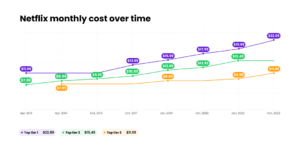Is it really ‘Netflix and Chill” if it costs more to subscribe every few months?
Apple TV just announced new price hikes, joining the likes of Netflix, Hulu, Apple TV, Disney, Peacock, etc., and other major streaming services that have increased their prices. And it may get worse, as the Wall Street Journal estimates a 25% annual increase in the cost of watching major streaming services ad-free.
With wall street investors pushing for more profit, navigating crippling inflation and low subscriber numbers, streaming services are flipping couches to account for every last dollar while trying to remain afloat in a difficult economy. As a result, they’re cracking down on password sharing and pushing the bulk of these costs to customers.
Key Notes
- The best streaming services, like Netflix, Hulu, Disney+, HBO Max, etc., have all hinted at or increased their prices recently.
- The monthly price of Netflix has gone from $8.99 to $15.99 since its launch.
- Apple TV just announced a 40% increase and now costs $9.99/month.
- Streaming companies cite a reduction in revenue and increased content production and maintenance as the major reasons for the price hike.
- Netflix and Disney have implemented and explored password-sharing crackdowns to boost subscriber numbers.
- Customers are opting for cheaper, ad-supported plans or switching to other free live TV streaming services.
Price changes for live TV streaming services
The table below shows the price increase of the most popular streaming services in the past year.
| Video Streaming Service | Launch Price ($) | Recent Price ($) |
| Netflix | 14.99 | 15.99 |
| Hulu | 9.99 | 14.99 |
| Disney+ | 6.99 | 10.99 |
| Apple TV | 4.99 | 9.99 |
| Peacock | 9.99 | 11.99 |
| Paramount + | 9.99 | 11.99 |
| HBO Max | 14.99 | 15.99 |
The pricing indicated is for the lowest ad-free tier.
3 Reasons why streaming services are raising their prices
All the major Live TV streaming services are raising their prices for three major reasons. Let’s explore them below.
Increasing costs and dwindling revenue
The streaming industry is growing at a fast and brutal pace, with providers competing for a limited number of subscribers and content. This is why it’s easy to find all your favorite classic movies and TV shows on at least one on-demand streaming service.
However, the costs of maintaining these platforms in the past few quarters have increased with rising inflation and interest rates, but the revenue per customer has remained stagnant or reduced.
For example, Netflix is expected to spend about $17 billion on content in the 2023 fiscal year but noted a drop in revenue per customer in the most recent quarter from all regions except the U.S. and Canada, which recorded a mere $0.05 revenue increase. Disney is expected to spend $30 billion this year but only recorded a 2% increase in revenue per customer quarterly.
So why are they raising their prices? It’s simple: to make a reasonable profit.
All streaming services make revenue from two main sources – the ads and subscriptions on lower-tiered, ad-supported packages and the subscriptions on ad-free packages. Since lower-tiered packages bring revenue from two sources, and the subscriptions from an ad-free tier do not bring in enough revenue, many service providers are increasing the cost of ad-free plans. This is to push more subscribers to a lower and ad-supported tier to increase the average revenue per customer.
More competition, fewer subscribers
With the number of streaming providers increasing every year, subscribers are spread out across different platforms, causing even the major ones, like Disney, Netflix, Amazon Prime Video, etc, to notice a decline. For example, DisneyPlus reported a loss of 12 million subscribers in the second quarter of this year. Netflix also reported its first loss of subscribers in April 2022.
With many subscribers charging within the same price range, many streaming services may not survive the steep competition.
Fewer subscriptions mean reduced profitability, forcing these paid streaming services to come up with different strategies to increase revenue. Netflix responded to the loss of subscribers by cracking down on password sharing, stopping multiple users from accessing the same account, and causing quite a stir in the industry. The idea behind this strategy was to stop people from sharing one subscription and pushing them to pay for new accounts.
Well, it worked, and Netflix recorded increased subscriptions in the following months. However, revenue growth still fell below expectations, making stakeholders wonder how effective the password-sharing limitation is in the long term.
Disney has decided to follow in Netflix’s footsteps and has announced a crackdown on password sharing coming in 2024. This is all to make streaming as profitable as possible. Some other strategies these on-demand streaming services use to increase revenue are reducing content spending, canceling shows for tax breaks, and selling anticipated shows to other platforms. So, if your favorite show was canceled without warning, now you know why!
Lower prices are unsustainable.
When streaming services became mainstream, they launched with very low prices, gaining mass consumer interest and causing more people to switch from cable TV. In the beginning, the huge subscriber numbers were a major green flag for Wall Street investors. However, as more competition surfaced and revenue dwindled, it became necessary for companies to improve their bottom line to stay in business.
With all the issues explained earlier, it is clear that lower prices are not sustainable, and they will keep increasing if the industry remains the same. All the major players in Hollywood must make a profit. With the 2023 SAG-AFTRA strike causing writers, extras, editors, and other vital production stakeholders to rightfully ask for better pay, there is concern that the bulk of these costs may be pushed to the consumers yet again.
Also, the U.S. and Canadian audiences are major consumers of streaming services. With both countries’ economies suffering, investors are unwilling to dump money in companies that are not delivering profit within certain, immediate timeframes. High subscriber numbers are no longer proof of viability, as investors want to see profitability more than anything else.
The ripple effect
As streaming companies keep increasing their prices, viewers will keep devising strategies to avoid these costs. Some viewers already subscribe to fewer niche streaming services and are actively churning between platforms.
Studies show that about 37% of consumers in the U.S. canceled a streaming service subscription in 2022. Customers are also opting for cheaper streaming plans per month or completely switching to a free streaming service like Tubi or Pluto. Some are even switching to cable TV options that stream over the internet, such as YouTube TV or Hulu + Live TV. However, the cost of these are also rising. Many customers also hunt for promotional streaming deals and take advantage of free trials on various platforms.
The prices of all the streaming services will not be reduced anytime soon. As companies struggle to remain profitable amidst investor pressure, customers may have to shoulder some of these costs and deal with more ad-supported options.



